UB-1 class (1914-18)
 German Empire – 20 submarines, UB-1 to UB-17, Austro U-10 to U-17, SM UB-3 to UB-14
German Empire – 20 submarines, UB-1 to UB-17, Austro U-10 to U-17, SM UB-3 to UB-14
WW1 German U-Boats
Brandtaucher | Forelle | U-1 | U-2 | U-3 class | U-5 class | U-9 class | U-13 class | U-17 class | U-19 class | U-23 class | U-43 class | U-57 class | U-63 class | U-87 class | U-93 class | U-139 class | U-142 class | UA | UB-I class | UB-II class | UB-III class | UC-I class | UC-II class | UC-III | Deutschland | UE-I class | UE-II class | U-ProjectsThe Type UB I submarine (or “UB-1 class”) were small coastal submarines or “Küsten U-boats” built from the start of the First World War for patrol and defensive purposes. Twenty of the UB-I type were built in all, most of which went into service with the German Imperial Navy until the end of #WWI. Some were also operated by the Austro-Hungarian Navy as U-10 class, and Bulgarian Navy. 8 were either sunk or lost without known causes during the war. The remainder were scuttled, scrapped, and three went to the allies as war reparation.
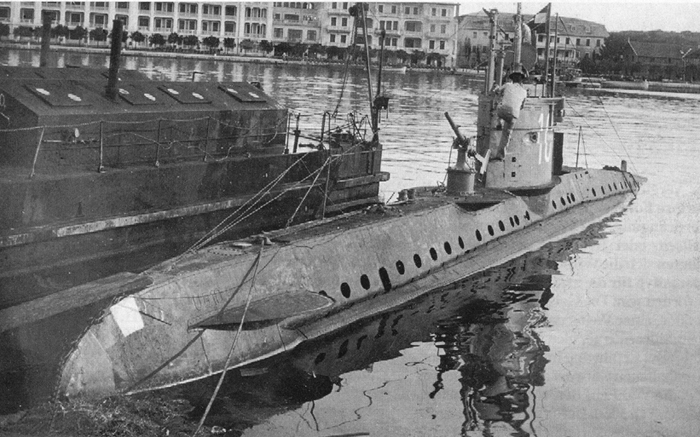
UB-I in port, Flanders. The crews often jockingly painted eyes and nostrils on the bows of the “tin tadpoles”. Officially they were known as the Project 34.
Design Development of the UB-I Type
The UB type was not a peacetime development but rather a wartime reflexion on how best to use recently conquered territories in Belgium, with a balcony on the shallow seas off Flanders. Indeed in the earliest stages of the War the German Army’s rapid advance along the North Sea coast opened new possibilities that no Submersible type was able to exploit. What was needed was a small coastal boat fit for the narrow and shallow seas of the area. So it’s on 18 August 1914 (two weeks after the German invasion of Belgium) that this planning started.
How to best use these ports to disrupt entente merchant traffic and activities at large was the main objective. For this, the German Naval high Command specified a small, maneuverable submarine able to operate in these difficult waters. They were also to be cheaply and quickly constructed, shipped by rail in section to the Flanders coast, and assembled right in the operating harbour with minimal facilities. The design development phase started by mid-August 1914 already. By mid-October 1914, it was ready and approved. The first 15 boats were ordered from two German shipyards (see later). The German Imperial Navy later ordered two more to replace those sold to Austria-Hungary which found these were well adapted to its own Adriatic waters. Austro-Hungary then ordered a further three more by April 1915.
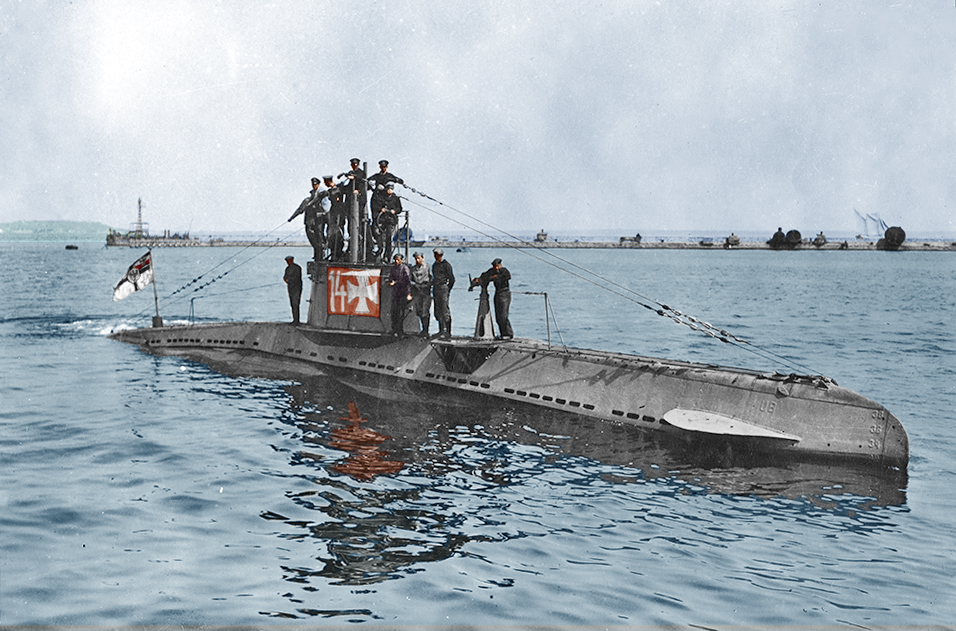
UB-14 (as shown on her flag) and crew – Colorization by the author.
Final design
The Navy’s main complex specification that was the UB-I type (“Project 34”) was to be transportable by rail and thus, due to the width of regular railway cars and space between those on a two-way rail section, this imposed a diameter of no more than 3.15 metres (10 ft 4 in).
Hull Design
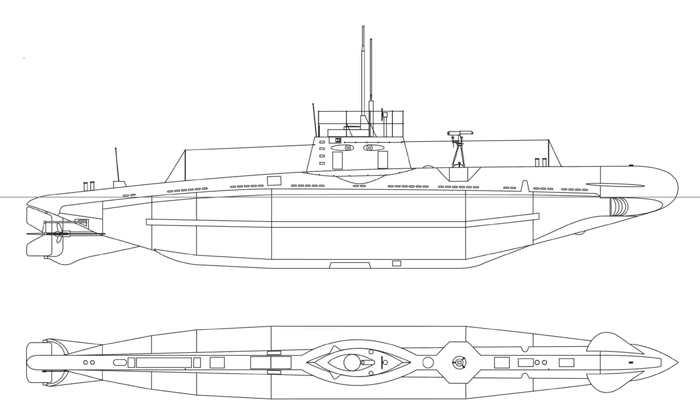
General scheme of the class (cc)
The UB-I were indeed small U-boats, just 28 metres (92 ft) long, to be exact ranging from 27.88 to 28.10 m (91 ft 6 in to 92 ft 2 in) overall depending of the builder, and the same 23.62 m (77 ft 6 in) pressure hull. In height 7.30 m (23 ft 11 in) with the masts up, and for draught just 3.03 m (9 ft 11 in), which was perfect for the aforementioned shallow waters of the area. The twelve Weser-built boats came in 22 centimetres (8.7 in) shorter than their counterparts.
This was for 127 tonnes (125 long tons) in displacement surfaced, up to 142 tonnes submerged. They just had two bow torpedo tubes, two spare torpedoes (they sailed with two already in the tubes). When surface for self-defence against airplanes, they had a deck-mounted machine gun, forward of the CT on a platform. Indeed the “deck” was quite narrow, about 80 cm only. The hull was rounded forward, pointy aft with a clear separation of the pressure hull, a few traps, seemingly no anti-slip serrations on deck, but a single starboard side wire-type barrier.
The conning tower was minimalistic as well, with a rigid part about 1.50 meters (5 ft) tall, elliptical in section, with a side step, hand guard, and ladded aft to the roofdeck. Forward of it was located CT hatch, secondary steering wheel, masts and periscope, with the froward part behind a barrier usually canvas-wrapped, but subjected to heavy sea spray anyway. These boats were clearly not at ease in heavy weather and choppy seas anyway. Steering was done thanks to the stern rudder, with cross-style planes linked to the steering hub by rocking arms. For diving there were steering planes forward.
Powerplant and Performances
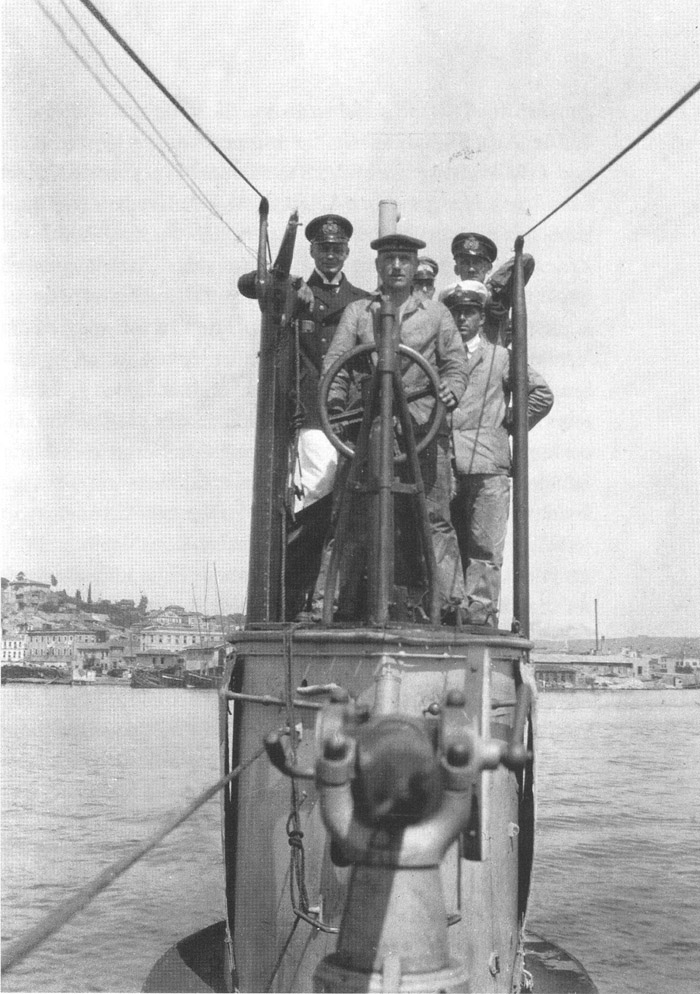
The driver at post on the kiosk and part of the crew behind. These submarines were so small they were commanded by Lieutenants (Lieutenant zür zee). The crew tried to keep its humor despite the very cramped conditions.
These small boats only needed a small and cheap powerplant compared to other U-Boats. They had thus a single Daimler (UB-1–UB-8) or Körting (UB-9 to 20) four-cylinder diesel engine rated for 59 bhp (44 kW) for surface run, and while underwater, they were powered by a single Siemens-Schuckert electric motor rated for 118 shp (88 kW). The single shaft did not helped for agility but was constrained by the small diameter.
As for performances, the UB-I were capable of only 6.47 knots (11.98 km/h; 7.45 mph) surfaced and 5.5 knots (10.2 km/h; 6.3 mph), submerged. Indeed, they were not intended to cruise long distances, rather to join a patrol point close to shore. The Weser (Bremen-built) boats could reach 7.5 knots (13.9 km/h; 8.6 mph) surfaced and 6 knots (11 km/h; 6.9 mph) submerged while the Germaniawerft boats were one knot slower.
Range was of course limited, but thanks to the diesel they still managed to reach if needed 1,650 nmi (3,060 km; 1,900 mi) at 5 knots (9.3 km/h; 5.8 mph) surfaced and 45 nmi (83 km; 52 mi) at 4.5 knots (8.3 km/h; 5.2 mph) submerged.
Test depth was calculated was 50 metres (160 ft) and they could dive in 33 seconds as measured (best time).
Armament
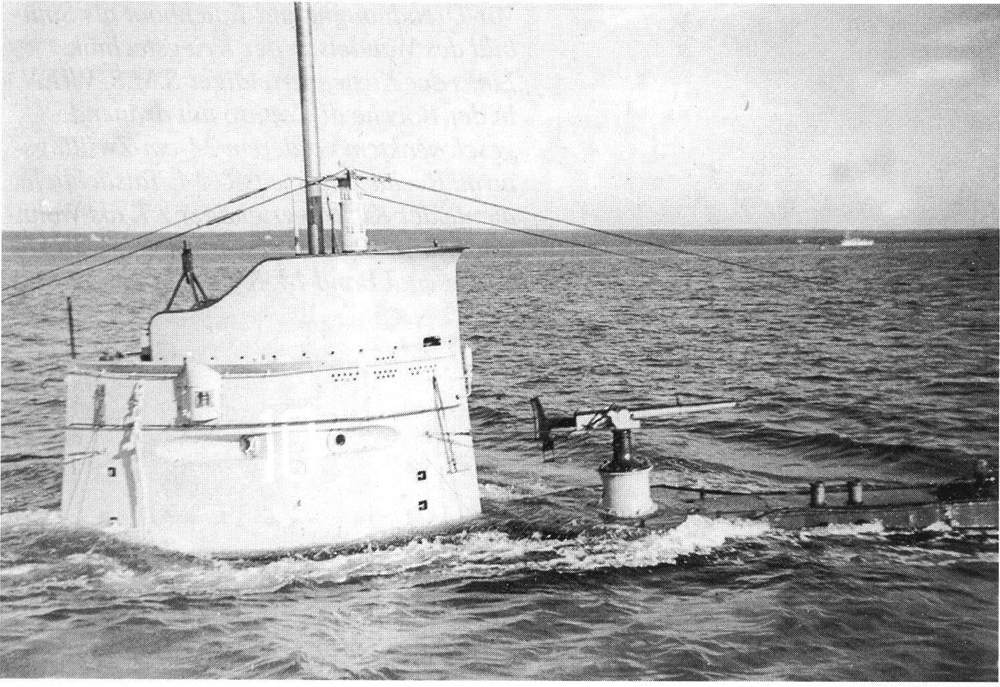
Kiosk and MG.
Again the size limited possibilities. They had only a pair of bow tubes, standard caliber of 45 cm (18 inches). These were of the 45 cm (17.7″) C/06 and C/06 D type. They had a 4-cylinder Brotherhood powrplant, Wet Heater, for a setting of 1,640 yards (1,500 m)/34.5 knots or 3,380 yards (3,000 m)/26 knots for the C type and 5,470 yards (5,000 m)/27 knots for the D type.
They weighted 1,704 lbs. (773 kg) or 1,786 lbs. (810 kg) for 222 in (5.650 m) in lenght, and carried a 270 lbs. (122.6 kg) TNT explosive Charge. It seems they only had the two torpedoes already pre-loaded in the tubes due to the lack of space. Their mission was really suited only for 24 to 48h sorties.
This was completed by a machine-gun, 8 mm (0.31 in) on a pintle mound forward (type unknown). It seems on most photos it was replaced at some point by a 37 mm Hotchkiss gun. This was in addition to personal weapons, mostly pistols and a few rifles due to the lack of space.
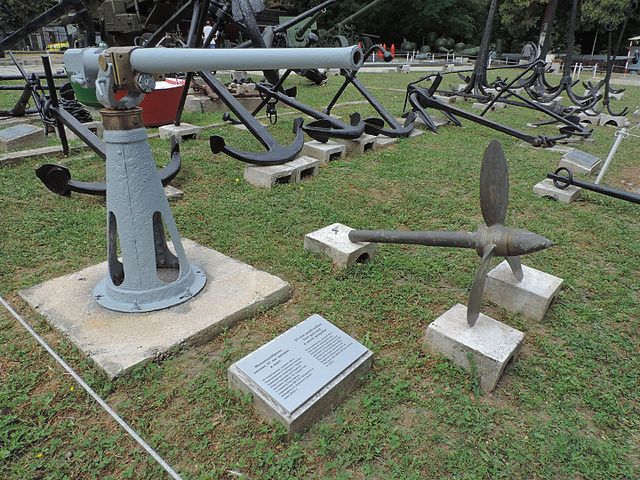
Hotchkiss 37 mm deck gun at Varna, former Bulgarian UB-8 or Podvodnik No. 18

⚙ specifications |
|
| Displacement | 127 tonnes surfaced, 142 tonnes submerged |
| Dimensions | 28.10 x 3.15 x 7.30 m (92 ft 2 in x 10 ft 4 in x 23 ft 11 in) |
| Propulsion | 1 shaft 4-cyl. diesel 59 bhp (44 kW), electric motor 118 shp (88 kW) |
| Speed | 6.47 knots surfaced, 5.5 knots submerged |
| Range | 1,650 nmi/5 knots surfaced, 45 nmi/4.5 knots submerged |
| Armament | 2× 45 cm TTs bow, 8 mm (0.31 in) LMG |
| Test depht/diving time | 50 metres (160 ft), 33 sec. |
| Crew | 14 |
Construction
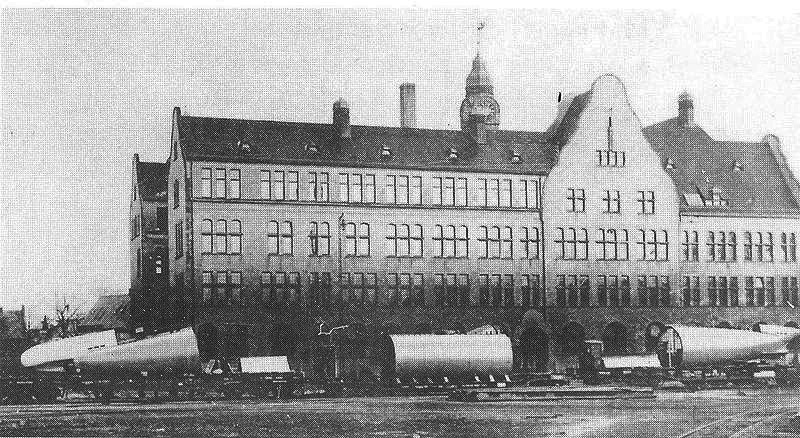
A dismounted UB Type being delivered by rail to the Flanders coast (building unidentified -this should gave the name of yard potentially). It shows the hull is cut unto three sections, so three flatbed carriages. They were broken down down into a knock down kit of fifteen pieces, so the real ensemble needed eight railway flatcars (for the example the powerplant was separated). Type UB I of the Flanders Flotilla needed a five-day journey to Antwerp and three-week assembly time. From Antwerp they were towed by barge to Bruges for trials. Similar things happened for the Mediterranean, they were conveyed to Pola for assembly in about a week, with total time from departure to operational readiness being six weeks.
A total of 20 UB Is were built total, from Germaniawerft of Kiel and AG Weser of Bremen, with some differences between the two series. Tthe first started in early November 1914 and all 20 were completed by October 1915, not as fast as intended, but way faster than usual U-Boats anyway. The first boats performed their sea trials in German home waters as a proof od concept, the remainder being as planned, loaded on railways carts to be sent in sections as intended to the Flanders coast. The ones under German control arrived in Antwerp, which had the best facilities, and the remainder in Pola. The earliest boats, completed in the Baltic stayed there. Some Austro-Hungarian boats were sent to the Constantinople Flotilla as well, as a deterrente to Aegean and Ionian entente operations (and the Dardanelles campaign).
Eight boats (UB-1 to UB-8) came from Germaniawerft of Kiel, seven boats (UB-9 to U-15) from AG Weser. UB-1 and UB-15 were sold in February 1915 to Austria-Hungary (“U-10” and “U-11”), thus UB-16 and UB-17 were ordered in replacement from Weser. Austria-Hungary wanted more and obtained in supplement the U-15, U-16, and U-17 ordered from Weser in April.
UB-1 and UB-2 were laid down on 1 November 1914 at the Germaniawerft, launched on 22 January 1915 and completed 75 days later. For UB-2 that was on 13 February. UB-9 was the first Weser boat laid down on 6 November 1914, launched on 6 February 1915, just a week ahead of UB-2. A natural competition developed between the two yards. These first three underwent trials in home waters to assess their capabilities before modifications on the ones in completion. When they revealed positive, the rest of the boats were directly delivered unassembled, to be shipped via rail. So they made their trials at their assembly point. By July 1915 all 17 German Type UB Is had been completed.
Critics
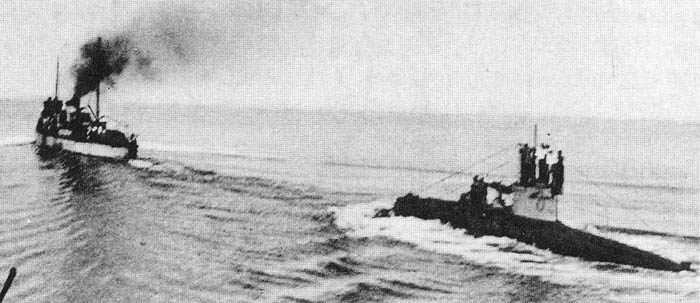
Because of the short range and speed of the small coastal submarines of the UB-I class were often towed to their deployment sites. Here, UB-14 in Otranto.
During trials the Type UB-Is as expected were hated by the crews of 14 men as being way cramped. Captains were not happy either as they were too small to deal with bad weather, and too slow, even underpowered. This was a real issue in case of strong currents (which was the case in flanders). One commander also nicknamed it a “sewing machine” due to excessive noise and vibrations, something excpected for a “kit assembly”.
Authors R. H. Gibson and Maurice Prendergast states from reports that these even lacked power to chase down steamers while surfaced, and underwater endurance was dangerously low, rarely lasting beyond one hour. The single propeller/machinery meant that there was no redundancy. In case of failure, the sub was stranded and needed towing back to port. In fact it became customary to tow them to station and travelling longer distances.
Another noted issue was the tendency of the UB Type to break trim after firing torpedoes. They had compensating tanks designed to flood/offset the loss of a C/06 torpedo which with its 1,700-pound (770 kg) weight had some effect on the small subs, but the system never worked properly, and at periscope depth the boat could either surged to the surface or plunged down. When UB-15 torpedoed the Italian Medusa in June 1915, the tank failed to compensate. The crew had to run to the stern to offset the imbalance.
Nevertheless, since the “tin tadpoles” Type had no equivalent, they were active until the last day of the war, half being lost through three flotillas.
Legacy
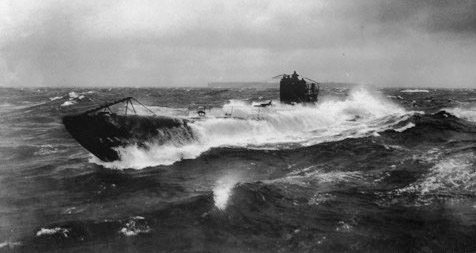
UB-148 at sea. The mass-produced UB-III type (145 completed) was the tipping point of the UB lineage and direct ancestor of the WW2 Type VII.
The experience very much motivated the naval staff to design better boats: The Type UB-II answered the same specifications but they were improved at any level, and larger at 263–279 t surfaced or 292–305 t submerged for 36.90 m long. 30 were built in 1915-1916, and some later given as war prizes served until 1931. As for he UB-III type of 1916, they really were larger and in fact, constituted the real start of the interwar legendary Type VII design. So the UB-I type despite of all their shortcomings, were really the starting point of a lineage leading to the most produced and perhaps famous submarine type in history…
The UB-I Type in service
Flanders Flotilla
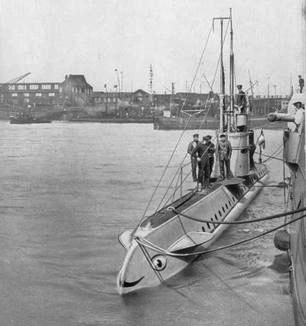 The first Type UB I to enter service was UB-10 for the Flanders Flotilla on 27 March 1915. In late April five more joined her: UB-2, UB-4, UB-5, UB-6, UB-12, UB-13, UB-16, and UB-17 with UB-2 being the only one towed in Flanders. UB-4 made its first patrol on 9 April 1945 and sank a first ship. Over time, an area of patrol was defined between the United Kingdom and Netherlands with sweeps in the English Channel. Indeed UB-6 managed to go past the British antisubmarine nets and minefields, mapped a route in the Straits of Dover by late June which was rapidly transmitted to all captains.
The first Type UB I to enter service was UB-10 for the Flanders Flotilla on 27 March 1915. In late April five more joined her: UB-2, UB-4, UB-5, UB-6, UB-12, UB-13, UB-16, and UB-17 with UB-2 being the only one towed in Flanders. UB-4 made its first patrol on 9 April 1945 and sank a first ship. Over time, an area of patrol was defined between the United Kingdom and Netherlands with sweeps in the English Channel. Indeed UB-6 managed to go past the British antisubmarine nets and minefields, mapped a route in the Straits of Dover by late June which was rapidly transmitted to all captains.
However in 1915 UB-4 and UB-13 were lost, and UB-2 and UB-5 were transferred to the “quieter” Baltic Flotilla. By March 1917 UB-6 ran aground in Dutch waters, interned. The four remaining (UB-10, UB-12, UB-16, UB-17) were eventually converted to minelayers in 1918 with their torpedo tubes removed, and four with oblique chutes fitted instead to carry up to eight mines. Indeed, the channel defencse not only had been reinforced, but the density of patrol vessels made it very hard for these slopw submersible to operate in safety, especially after the better UB-II type came out. As mionelayers they sortied in the evening and operated at night. Only UB-10 managed to survived until the end of 1918 but she was scuttled in October when the Germans evacuated Flanders.
Baltic Flotilla
The UB-I was equally suited for the confines of the Baltic: UB-9 was initially assigned to the Baltic, soon joined by UB-2 and UB-5 in early 1916 (from the Flanders). After seeing little service they became training boats at Kiel in 1916 for UB-II crews, and joined UB-11 already kept for this. For their fate, they all survived the war and were BU postwar.
Constantinople Flotilla
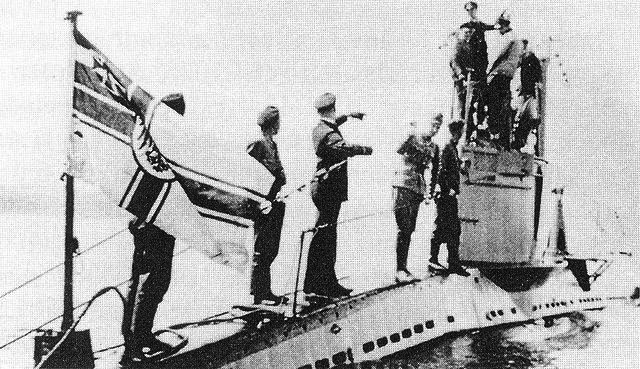
UB-14 showing its flag
Four of German boats, UB-3, UB-7, UB-8, plus UB-14 were selected for service with the Constantinople Flotilla, sent to Pola for assembly and trials as part of the Pola Flotilla and then joining the Constantinople Flotilla. UB-3 disappeared en route in May 1915, the other three arrived there by mid-June. In all, the Austro-Hungarians received two of and later three more, plus one to Bulgaria.
The three German Type UB I boats of the Constantinople Flotilla patrolled in the Black Sea and UB-8 was transferred to the Bulgarian Navy in May 1916. UB-7 disappeared in the Black Sea (October 1916) and UB-14 surrendered at Sevastopol in November 1918 to French armies during the Russian Civil War.
One of the five Austro-Hungarian boats one was sunk, another mined. The three surviving ones and sole Bulgarian boat were catpured by the entente and broken up.
Austro-Hungarian Boats (U-10 class)
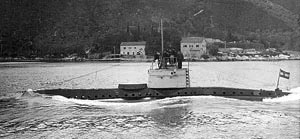 UB-1 and UB-15 were sold to Austria-Hungary (February 1915) shipped to Pola for assembly in May 1945. At first they served under the German flag, but later properly commissioned into the Austro-Hungarian Navy. The UB-1 and 15 were renamed U-10 and U-11, and later joined by U-15, U-16, and U-17 (October 1915). They operated from Pola in the Adriatic, along the coast of Albania. U-10 hit a mine in July 1918. She managed to beach but was never repaired. U-16 torpedoed an Italian destroyer in October 1916 but was chased off and depht-charged, lost. The remaining three went to Italy as war reparation.
UB-1 and UB-15 were sold to Austria-Hungary (February 1915) shipped to Pola for assembly in May 1945. At first they served under the German flag, but later properly commissioned into the Austro-Hungarian Navy. The UB-1 and 15 were renamed U-10 and U-11, and later joined by U-15, U-16, and U-17 (October 1915). They operated from Pola in the Adriatic, along the coast of Albania. U-10 hit a mine in July 1918. She managed to beach but was never repaired. U-16 torpedoed an Italian destroyer in October 1916 but was chased off and depht-charged, lost. The remaining three went to Italy as war reparation.
Bulgarian Podvodnik No.18
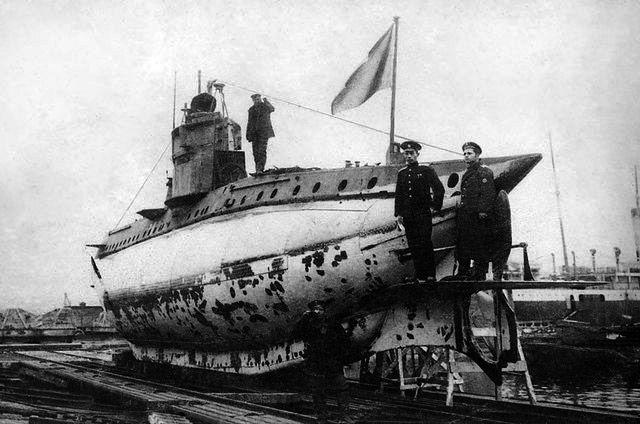
Podovnik N°18
The very first Bulgarian submarine was the ex-UB-8 transferred in May 1916 and renamed Podvodnik No.18. She served in coastal defense off Bulgaria’s Black Varna port area. She survived the war and was ceded to France by treaty.
 UB-1 to 17
UB-1 to 17
UB 1 Commissioned 29 Jan 1915 as under command between 29 Jan 1915 and 9 Jul 1915 of Oblt. Franz Wäger. In service with the Austro-Hungarians as U10 from 12 July 1915. 1 warship sunk at 120 tons. She was lost on 9 Jul 1918 by hitting a mine near Caorlé. Raised 25 July 1918 to Italy 1920, BU.
 UB 2 commissioned 10 February 1915 under Captain Werner Fürbringer, Karl Neumann, Thomas Bieber, Harald von Keyserlingk, made 38 patrols with Flanders Flotilla, Baltic Flotilla and from December 1916 until 11 Nov 1918 with the training Flotilla. She had 11 ships sunk for 1,374 tons. Stricken 19 Feb 1919 BU at Stinnes 3 Feb, 1920.
UB 2 commissioned 10 February 1915 under Captain Werner Fürbringer, Karl Neumann, Thomas Bieber, Harald von Keyserlingk, made 38 patrols with Flanders Flotilla, Baltic Flotilla and from December 1916 until 11 Nov 1918 with the training Flotilla. She had 11 ships sunk for 1,374 tons. Stricken 19 Feb 1919 BU at Stinnes 3 Feb, 1920.
UB 3 commissioned 14 Mar 1915. Captain Siegfried Schmidt, 1 patrol May 1915 – 23 May 1915 Pola Flotilla. 23 May 1915 – Lost Aegean Sea, all hands.
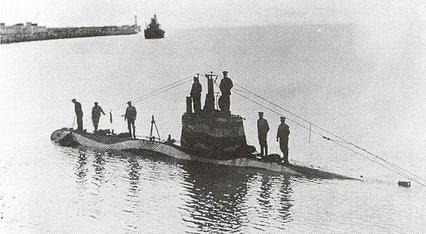
A camouflaged early UB-I type
UB 4 was commissioned on 23 Mar 1915, commanded by Oblt. Karl Groß as most illustrious captain. She was successful, making 14 patrols until August 1915 as part of the Flandern Flotilla with 4 ships sunk (total 10,942 tons, Brazilian cargo Harpalyce, Greek Ellispontos, Belgian Princesse Marie Joseand the Brazilian trawler Bona Fide). She was sunk by gunfire on 15 Aug 1915 after trying to investigate the Q-Ship Inverlyon off Yarmouth, all hands lost.
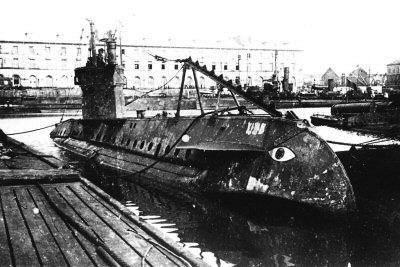 UB-5 was commissioned on 25 March 1915 with most prominent captain Oblt. Wilhelm Smiths. She made 24 patrols, and from 9 Oct 1915 to 21 Sep 1916 was versed in the Baltic Flotilla and from there to 11 Nov 1918 she was in the training Flotilla. She sank 5 small ships, mostly British trawlers (996 tons) and was stricken in February 1919, BU in Lübeck.
UB-5 was commissioned on 25 March 1915 with most prominent captain Oblt. Wilhelm Smiths. She made 24 patrols, and from 9 Oct 1915 to 21 Sep 1916 was versed in the Baltic Flotilla and from there to 11 Nov 1918 she was in the training Flotilla. She sank 5 small ships, mostly British trawlers (996 tons) and was stricken in February 1919, BU in Lübeck.
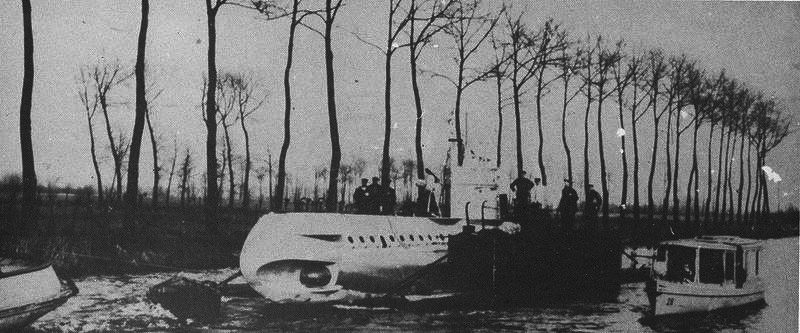
UB-6 transiting the Zeebruge canal in Belgium
UB-6 Commissioned on 8 Apr 1915, had a long career under Oblt. Erich Haecker, Ernst Voigt, Karl Neumann (both from the Royal House Order of Hohenzollern), Karsten von Heydebreck and Oskar Steckelberg, accumulating 60 patrols and making one of the longest service with the Flandern Flotilla, until 12 March 1917. She was relatively successful, sinking 15 ships for a total of 5,966 tons, two more damaged (total 1,098 tons) one taken as prize (1,328 tons) and another sunk at 335 tons: 6 steamers, 7 trawlers, and a 336 tons destroyer under Hacker, the HMS Recruit.
On 18 March 1917 UB-6 luck turned as she ran aground on the 12th, was spotted by the neutral Dutch Navy and captured for internment. She sank at Hellevoetsluis while interned, but later reloated and ceded to France in 1919, BU in Brest in July 1921.

UB-6 and her tender Holland.
UB-7 commissioned on 6 May 1915 as Oblt. Wilhelm Werner (awared Pour le Mérite medal) and Oblt. Hans Lütjohann with 15 patrols, assigned to the Pola flotilla as built until 21 June 1915 and then until 27 September 1916 the Constantinople Flotilla. She sank four ships for 6,283 tons, best being the British steamer Patagonia 6,011 tons, and four trawlers. On 27 Sep 1916 she hit a mine in the Black Sea, 15 miles SE of Varna, sinking with all hands lost.
UB-8 commissioned on 23 April 1915 was commanded by Oblt. Ernst von Voigt, made 14 patrols until 4 June 1915 with the Pola Flotilla and then until 25 May 1916 with the Constantinople Flotilla single a single ship totalling 19,380 tons: The British passenger steamer SS Merion. She was surrendered to France after treaty on 25 Febrary 1919, BU at Bizerta in August 1921.
UB-9 commissioned 18 Feb 1915 under Oblt. Wilhelm Werner (Pour le Mérite) served all her career as a training boat in the baltic. For some authors, she was assigned to the Kiel Periscope School by September 1915. She made no patrol, no kill. Surrendered in 1919 she was stricken on 19 February and designated to be BU by Dräger of Lübeck in 1919.
UB-10 Certainly the UB Type with the most success, most decorated, successful and longest career. Commissioned on 15 Mar 1915 she had as captains Oblt. (Oberlieutenant) Otto Steinbrinck (Pour le Mérite), Reinhold Saltzwedel (Pour le Mérite), Gustav Buch, Wilhelm Amberger, Erich von Rohrscheidt, Ulrich Pilzecker, Matthias Graf von Schmettow, Erich von Rohrscheidt, Georg Reimarus, Fritz Gregor, Hellmut Lorenz, Erich Stephan, Freiherr Cassius von Montigny, Erich Stephan, Fritz von Twardowski, Joachim Emsmann and Willy Stüben, performing 115 patrols until 5 October 1918 with the dangerous Flandern Flotilla and sinking 36 ships for a total of 22,604 tons and a warship. Best kills were the Dutch steamer Katwijk (2,040 tons) on 14 April 1915, Belgian Menapier (1,886 t) on 7 June 1915, British Fulgens (2,512 t) on 1 Aug 1915, Rosalie (4,243 tons) on 10 Aug 1915, Huntly (1,153 tons), all under Otto Steinbrinck, the rest being 21 trawlers.
The rest were Port Dalhousie (1,744 tons) on 19 Mar 1916 and the Norwegian Peter Hamre (1,081 tons) both under Reinhold Saltzwedel, Gustav Buch sinking the British destroyer HMS Lassoo on 13 August 1916. Also notable was Erich von Rohrscheidt with in March-April 1917 claimed the Dutch Amstelstromm (1,413), Dutch Minister Tak Van Poortvliel (1,106). Fritz Gregor in August 1917 sank the largest steamer, Edernian (3,588 tons). On 5 Oct 1918 during the evacuation of Belgium, she was scuttled and sunk off the Flanders coast, having being converted as minelayer at the time. Unfortunately no photo of her.
UB-11 Presumably also a training boat. Commissioned on 4 Mar 1915 under Oblt. Ralph Wenninger (Pour le Mérite) she made no patrols, and was handed over to the entente, stricken on 19 Feb 1919 and BU by Stinnes on 3 Feb 1920.
UB-12 was another successful UB types. Commissioned on 29 Mar 1915 she was commanded by Oblt. Hans Nieland, Wilhelm Kiel, Georg Gerth, Friedrich Moecke, Ernst Steindorff, Günther Wigankow, Wilhelm Braun, Freiherr Nikolaus von Lyncker and Ernst Schöller through 98 patrols for the Flanders Flotilla until 19 August 1918 sinking 22 ships for a total of 10,263 tons, one captured (654 tons) and another sunk of 995 tons. She sank with all hands after hitting a mine. Best “kill” was on 10 April 1916 the SS Silksworth Hall (4,777 tons).
 UB-13 Commissioned on 6 Apr 1915 under Oblt. Walther Gustav Becker, Karl Neumann and Arthur Metz she made 36 patrols until 24 April 1916 with the Flanders Flotilla, sinking 11 ships for 17,665 tons, one captured. Best kill was the Dutch liner Tubantia (13,911 tons) on 16 March 1916 which caused another internaitonal outrage. She hit a mine net off the Belgian coast and sank with all hands.
UB-13 Commissioned on 6 Apr 1915 under Oblt. Walther Gustav Becker, Karl Neumann and Arthur Metz she made 36 patrols until 24 April 1916 with the Flanders Flotilla, sinking 11 ships for 17,665 tons, one captured. Best kill was the Dutch liner Tubantia (13,911 tons) on 16 March 1916 which caused another internaitonal outrage. She hit a mine net off the Belgian coast and sank with all hands.
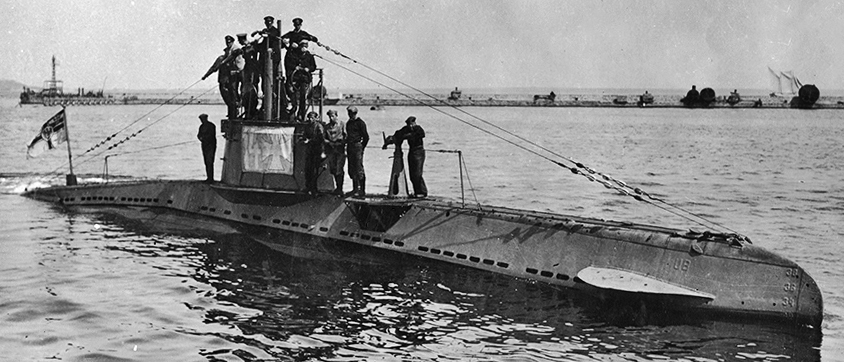
UB-14 commissioned 25 Mar 1915 was commanded by Oblt. Heino von Heimburg (Pour le Mérite), Albrecht von Dewitz, Heino von Heimburg (Pour le Mérite), Kurt Schwarz, Ernst Ulrich, Bodo Elleke, making 22 patrols with the Pola Flotilla until 24 July 1915 and Constantinople Flotilla until 11 November 1918. She sank 4 ships (total 13,610 tons) with best kills being on 7 July 1915 under Heino von Heimburg the Italian armoured cruiser Amalfi (10,118 tons), which pretty much the entire Italian doctrine in the Adriatic since surface ships were forbidden access (except fast cruisers and destroyers among others) and the Otranto Barrage was setup until the end of the war. In that sense, UB-14 made history. Another rare success was on 6 Nov 1915 when Heino von Heimburg managed to sunk the British submarine E 20 as part of the Dardanelles Campaign. The largest civilian kill was the Canadian liner Royal Edward (11,117 tons) carerying troops (on 13 August 1914). In July 1916 she attacked the Russian battleship Imperatritsa Mariya but was repelled by her screen of destroyers. So even if her “hunting board” was not impressive, she was perhaps the second most successful UB type boat.
By November 1918 she came under Allied control at Sevastopol and was scuttled off Sevastopol in early 1919.
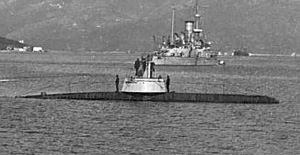 UB-15: Commissioned on 11 Apr 1915, operated under Oblt. Heino von Heimburg (Pour le Mérite) with the Pola Flotilla. She was transferred to the Austro-Hungarian navy on 18 June, 1915, becoming U11 but only sunk the 245 tons warship Medusa. She was broken up at Pola in 1919.
UB-15: Commissioned on 11 Apr 1915, operated under Oblt. Heino von Heimburg (Pour le Mérite) with the Pola Flotilla. She was transferred to the Austro-Hungarian navy on 18 June, 1915, becoming U11 but only sunk the 245 tons warship Medusa. She was broken up at Pola in 1919.
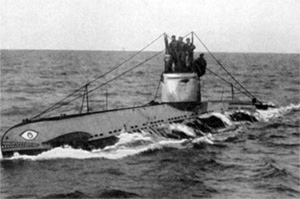 UB-16: Commissioned on 12 May 1915 she served under Oblt. Hans Valentiner, Paul Hundius (Pour le Mérite), Ernst Müller-Schwarz, Hans Ewald Niemer, Hugo Thielmann, Wilhelm Rhein, Alfred Krameyer, Oblt. Rudolf Stier and Vicco von der Lühe performing 87 patrols until 10 May 1918 with the Flanders Flotilla, sinking 24 ships for 18,711 tons, one 5,822 tons badly damaged, one prize and a 1,075 tons warship, the destroyer USS Recruit. Largest steamers sank were Leuctra (3,027 tonnes), Tunisiana (4,220), Robert Adamson (2,978), Tregantle (3,091), and Kongsli (5,822). She sunk, torpedoed on 10 May 1918 by HMS E34 in the North Sea with just a single (very lucky) survivor.
UB-16: Commissioned on 12 May 1915 she served under Oblt. Hans Valentiner, Paul Hundius (Pour le Mérite), Ernst Müller-Schwarz, Hans Ewald Niemer, Hugo Thielmann, Wilhelm Rhein, Alfred Krameyer, Oblt. Rudolf Stier and Vicco von der Lühe performing 87 patrols until 10 May 1918 with the Flanders Flotilla, sinking 24 ships for 18,711 tons, one 5,822 tons badly damaged, one prize and a 1,075 tons warship, the destroyer USS Recruit. Largest steamers sank were Leuctra (3,027 tonnes), Tunisiana (4,220), Robert Adamson (2,978), Tregantle (3,091), and Kongsli (5,822). She sunk, torpedoed on 10 May 1918 by HMS E34 in the North Sea with just a single (very lucky) survivor.
UB-17 Commissioned on 4 May 1915 under Oblt. Ralph Wenninger (Pour le Mérite, a WW2 U-Ace by the way), Arthur Metz, Werner Fürbringer, Friedrich Moecke, Günther Suadicani, Hans Degetau, Ulrich Meier, Georg Niemeyer, Günther Wigankow, Johannes Ries, Albert Branscheid, performing 91 patrols until 15 March 1918 in the Flandern Flotilla and sinking 13 ships for 2,186 tons.
She damaged the 4,054 tons steamer Batoum on 18 July 1915, sinding her in drydock for many months. She also took two prizes for 316 tons. On 15 March 1918 she was sailing from Zeebrugge from March 11, 1918 when disappeared, all hands lost. Historians attributed this to a mine by default.
All in all, these UB-I did remarkably well for their tonnage. But they were outdone by the UB-II by far.

One famous example was UB-18, commissioned on 10 Dec 1915 served under Oblt. Franz Wäger, Otto Steinbrinck (Pour le Mérite), Claus Lafrenz, Ulrich Meier, Georg Niemeyer and made 31 patrols with the Flanders Flotilla until 9 Dec 1917, sinking a whooping 127 ships (total 130,841 tons) making her the absolute top scorer of all UB-II types. She also badly damaged 5 more (total 7,576 tons) and also sank the 725 tons British submersible E22. She notably sank the French auxiliary cruiser Au Revoir (1,058 tonnes), large freighter Kelvinbank (4,200 tonnes), Norwegian SS Polynesia (4,064 tonnes), Greek Panaghi Lykiardopoulo (3,200 tonnes), Peebles (4,284 tonnes), and Russian Nonni (4,105 tonnes) among the largest. Not bad for a 280 tonnes boats right ? The rest were armed trawlers in majority. It’s one of them however which had the last laugh: She was rammed and sank with all hands on 9 Dec 1917 by the trawler Ben Lawer in the Channel…
Overall the UB-II were far more capable boats. They will be seen next.
 UB-I in Austro-Hungarian service
UB-I in Austro-Hungarian service
The U-10 class submarine was composed of UB I type boats, two transferred from German stocks plus three built specifically for Austria-Hungary. These were the U-10 (former UB-1), U-11 (former UB-15) and the tailor built U-15, U-16, U-17.
In addition four German Type UB-Is from the Flanders were assigned to the Pola Flotilla with at first German crews and later Austro-Hungarian designations:
SM UB-3 (U-9), UB-7 (U-7), UB-8 (U-8) and UB-14 (U-26). They remained under commission in the German Imperial Navy despite their designation, with also German crews and commanders and were under orders from the German flotilla commander at Pola.
 Bulgarian UB-Is
Bulgarian UB-Is
The purchase of two UB I boats for the Bulgarian Navy, UB-7 and UB-8 in 1916 was ongoing with Bulgarian sailors sent to Germany to learn their trade in Kiel. However before the transfer could be done, UB-7 was sunk. Thus UB-8 was officially transferred on 25 May 1916, changing her name to “Podvodnik No. 18”. She patrolled off Varna against Russian incursion during all the war, taking little risks as it seems, making no spotting or sinking.
Read More
Books
Bendert, Harald (2000). Die UB-Boote der Kaiserlichen Marine, 1914-1918. Verlag E.S. Mittler & Sohn GmbH.
Gröner, Erich; Jung, Dieter; Maass, Martin (1991). U-boats and Mine Warfare Vessels. German Warships 1815–1945. Vol. 2. Conways
Preston, Anthony (1978). U-Boats. London, England: Bison Books.
Baumgartner, Lothar; Erwin Sieche (1999). Die Schiffe der k.(u.)k. Kriegsmarine im Bild=Austro-Hungarian warships in photographs978-3-901208-25-6. OCLC 43596931.
Gardiner, Robert, ed. (1985). Conway’s All the World’s Fighting Ships 1906–1921.
Gibson, R. H.; Maurice Prendergast (2003). The German Submarine War, 1914–1918. NIP
Imperial and Royal Navy Association. “Tengeralattjárók” (PDF) Imperial and Royal Navy Association.
Йорданов, Николай (1999). Първата българска подводница (“The First Bulgarian Submarine”)
Jung, Dieter (2004). Die Kaiserliche Marine 1914-1918 und ihr Verbleib. Bernard & Graefe.
Karau, Mark D. (2003). Wielding the Dagger: the MarineKorps Flandern and the German War Effort, 1914–1918. Praeger Publishing.
Messimer, Dwight R. (2002). Verschollen: World War I U-boat losses. NIP
Miller, David (2002). The Illustrated Directory of Submarines of the World. St. Paul, Minnesota
Sokol, Anthony (1968). The Imperial and Royal Austro-Hungarian Navy. NIP
Stern, Robert Cecil (2007). The Hunter Hunted: Submarine versus Submarine: Encounters from World War I to the Present.
Tarrant, V. E. (1989). The U-Boat Offensive: 1914–1945. Annapolis NIP
Williamson, Gordon (2002). U-boats of the Kaiser’s Navy. Oxford: Osprey.
Links
uboat.net
navypedia.org/
dreadnoughtproject.org SMS_UB_2/
navweaps.com Pre WWII german Torpedoes
on en.wikipedia.org
on commons.wikimedia.org
Model Kits
on scalemates.com
on modelingmadness.com/
on combrig-models.com/
on mikro-mir.com/
on reviews.ipmsusa.org
on modelingmadness.com

 Latest Facebook Entry -
Latest Facebook Entry -  X(Tweeter) Naval Encyclopedia's deck archive
X(Tweeter) Naval Encyclopedia's deck archive Instagram (@navalencyc)
Instagram (@navalencyc)





 French Navy
French Navy Royal Navy
Royal Navy Russian Navy
Russian Navy Armada Espanola
Armada Espanola Austrian Navy
Austrian Navy K.u.K. Kriegsmarine
K.u.K. Kriegsmarine Dansk Marine
Dansk Marine Nautiko Hellenon
Nautiko Hellenon Koninklije Marine 1870
Koninklije Marine 1870 Marinha do Brasil
Marinha do Brasil Osmanlı Donanması
Osmanlı Donanması Marina Do Peru
Marina Do Peru Marinha do Portugal
Marinha do Portugal Regia Marina 1870
Regia Marina 1870 Nihhon Kaigun 1870
Nihhon Kaigun 1870 Preußische Marine 1870
Preußische Marine 1870 Russkiy Flot 1870
Russkiy Flot 1870 Svenska marinen
Svenska marinen Søværnet
Søværnet Union Navy
Union Navy Confederate Navy
Confederate Navy Armada de Argentina
Armada de Argentina Imperial Chinese Navy
Imperial Chinese Navy Marinha do Portugal
Marinha do Portugal Mexico
Mexico Kaiserliche Marine
Kaiserliche Marine 1898 US Navy
1898 US Navy Sovietskiy Flot
Sovietskiy Flot Royal Canadian Navy
Royal Canadian Navy Royal Australian Navy
Royal Australian Navy RNZN Fleet
RNZN Fleet Chinese Navy 1937
Chinese Navy 1937 Kriegsmarine
Kriegsmarine Chilean Navy
Chilean Navy Danish Navy
Danish Navy Finnish Navy
Finnish Navy Hellenic Navy
Hellenic Navy Polish Navy
Polish Navy Romanian Navy
Romanian Navy Turkish Navy
Turkish Navy Royal Yugoslav Navy
Royal Yugoslav Navy Royal Thai Navy
Royal Thai Navy Minor Navies
Minor Navies Albania
Albania Austria
Austria Belgium
Belgium Columbia
Columbia Costa Rica
Costa Rica Cuba
Cuba Czechoslovakia
Czechoslovakia Dominican Republic
Dominican Republic Haiti
Haiti Hungary
Hungary Honduras
Honduras Estonia
Estonia Iceland
Iceland Eire
Eire Equador
Equador Iran
Iran Iraq
Iraq Latvia
Latvia Liberia
Liberia Lithuania
Lithuania Mandchukuo
Mandchukuo Morocco
Morocco Nicaragua
Nicaragua Persia
Persia San Salvador
San Salvador Sarawak
Sarawak Uruguay
Uruguay Venezuela
Venezuela Zanzibar
Zanzibar Warsaw Pact Navies
Warsaw Pact Navies Bulgaria
Bulgaria Hungary
Hungary

 Bundesmarine
Bundesmarine Dutch Navy
Dutch Navy Hellenic Navy
Hellenic Navy Marina Militare
Marina Militare Yugoslav Navy
Yugoslav Navy Chinese Navy
Chinese Navy Indian Navy
Indian Navy Indonesian Navy
Indonesian Navy JMSDF
JMSDF North Korean Navy
North Korean Navy Pakistani Navy
Pakistani Navy Philippines Navy
Philippines Navy ROKN
ROKN Rep. of Singapore Navy
Rep. of Singapore Navy Taiwanese Navy
Taiwanese Navy IDF Navy
IDF Navy Saudi Navy
Saudi Navy Royal New Zealand Navy
Royal New Zealand Navy Egyptian Navy
Egyptian Navy South African Navy
South African Navy






























 Ukrainian Navy
Ukrainian Navy dbodesign
dbodesign